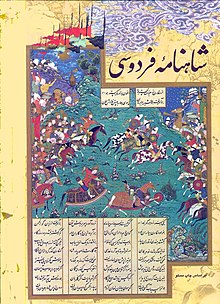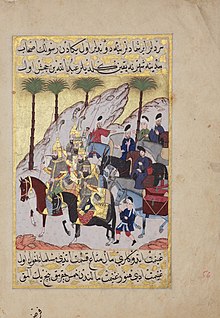Companions of the Prophet
This article includes a list of generalreferences,butit lacks sufficient correspondinginline citations.(October 2022) |
Ṣaḥāba | |
|---|---|
 Muhammad and his companions (Ottomanera) | |
| Personal | |
| Religion | Islam |
| Other names | Companions of the Prophet |
| Muslim leader | |
| Period in office | Early Islamic period Late antiquity |


TheCompanions of the Prophet(Arabic:اَلصَّحَابَةُ,romanized:aṣ-ṣaḥāba,lit. 'the companions') were the disciples and followers ofMuhammadwho saw or met him during his lifetime, while being a Muslim and were physically in his presence.[1]
Later Islamic scholars accepted their testimony of the words and deeds of Muhammad, the occasions on which theQuranwas revealed and other important matters inIslamic historyand practice. The testimony of the companions, as it was passed down through trusted chains of narrators (asānīd), was the basis of the developingIslamic tradition.From the traditions (hadith) of the life of Muhammad and his companions are drawn the Muslim way of life (sunnah), the code of conduct (sharia) it requires, and Islamicjurisprudence(fiqh).
The two largestIslamic denominations,theSunniandShia,take different approaches to weighing the value of the companions' testimonies, have differenthadithcollections and, as a result, have different views about the ṣaḥābah.[2]
The second generation ofMuslimsafter the ṣaḥāba, born after the death of Muhammad, who knew at least one ṣaḥāba, are calledTābi'ūn(also "the successors" ). The third generation of Muslims after theTābi'ūn,who knew at least oneTābi,are calledtābi' al-tābi'īn.[3]The three generations make up thesalafof Islam.
Etymology[edit]
The term sahaba means "companions" and derives from the verbصَحِبَmeaning "accompany", "keep company with", "associate with". "Al-ṣaḥāba" is definite plural; the indefinite singular is masculineصَحَابِيٌّ(ṣaḥābiyy), feminineصَحَابِيَّةٌ(ṣaḥābiyyah).
Types[edit]
In Islam, companions of Muhammad are classified into categories including theMuhajirunwho accompanied Muhammad fromMeccatoMedina,theAnsarwho lived in Medina, and the Badriyyun who fought at theBattle of Badr.[2][a][b][c]
Two important groups among the companions are theMuhajirun"migrants", those who had faith in Muhammad when he began to preach in Mecca and who departed with him when he was persecuted there, and theAnsar,the people ofMedinawho welcomed Muhammad and his companions and stood as their protectors.[d][e]
Lists of prominent companionsusually include 50 or 60 names of the people thought to be most closely associated with Muhammad. However, there were clearly many others who had some contact with Muhammad, and many of those names and biographies were recorded in religious reference texts such asibn Sa'd's earlyBook of the Major Classes.Al-Qurtubi'sIstīʻāb fī maʻrifat al-Aṣhāb(d. 1071 CE) consists of 2770 biographies of male and 381 biographies of female ṣaḥābah.
According to an observation inal-Qastallani'sAl-Muwahib al-Ladunniyyah,an untold number of persons had already converted to Islam by the time Muhammad died. There were 10,000 by the time of theConquest of Meccaand 70,000 during theExpedition of Tabukin 630. Some Muslims assert that they were more than 200,000 in number: it is believed that 124,000 witnessed theFarewell SermonMuhammad delivered after makingFarewell Pilgrimageto Mecca.[who?]
Definitions[edit]
Sunni[edit]
The most widespread definition of a companion is someone who met Muhammad, believed in him, and died aMuslim.The Sunni scholaribn Hajar al-Asqalani(d. 852 H) said,
The most correct of what I have come across is that a Sahâbî (Companion) is one who met the Prophet Muhammad, peace be upon him, whilst believing in him, and died as a Muslim. So, that includes the one who remained with him for a long or a short time, and those who narrated from him and those who did not, and those who saw him but did not sit with him and those who could not see him due to blindness.[4]
Anyone who died afterrejecting Islamand becoming an apostate is not considered as a companion. Those who saw him but held off believing in him until after his death are not considered ṣahābah, only tābiʻūn (if they saw the companions).
According to Sunni scholars, Muslims of the past should be considered companions if they had any contact with Muhammad, and they were not liars or opposed to him and his teachings. If they saw him, heard him, or were in his presence even briefly, they are companions. All companions are assumed to be just (ʻudul) unless they are proven otherwise; that is, Sunni scholars do not believe that companions would lie or fabricate hadith unless they are proven liars, untrustworthy or opposed to Islam.[5]
Some Quranic references are important to Sunni Muslim views of the reverence due to all companions;[6][7][8][9][10][11][f][g][h][i]It sometimes admonishes them, as whenAisha,wife of Muhammad and daughter of the first SunnicaliphAbu Bakr,was accused of infidelity.[j][k]
Differing views on the definition of a companion were also influenced by the debate between theTraditionalistsand theMuʿtazilawith the traditionalists preferring to extend the definition to as many people as possible and the Mu'tazilites preferring to restrict it.[12]
Shia[edit]
The Shia[13][14]as well as some Sunni scholars likeJaved Ahmad GhamidiandAmin Ahsan Islahifollow a stricter definition, believing that not every Muslim who met Muhammad should be considered a companion. In their view, the Qurʻan requires companions to demonstrate a high level of faith; thus, only those individuals who had substantial contact with Muhammad should be considered, e.g., those that lived with him, took part in military campaigns, or proselytized.[15]
This stricter definition means that the Shia consider each ṣaḥābiyy differently, depending on what they accomplished. They do not accept that the testimony of nearly all ṣaḥābah are an authentic part of the chain of narrators for a hadith. The Shia further argue that the righteousness of ṣaḥābah can be assessed by their loyalty towards Muhammad's family after his death, and they accept hadith from theImams of the Ahl al-Bayt,believing them to be cleansed from sin through their interpretation of the Qurʻan[l]and thehadith of the Cloak.
Shia Muslims believe that some of the companions are accountable for the loss of the caliphate byAli's family.[1]
As verses 30-33 fromAl-Aḥzāb,Shias believe their argument[where?]that one must discriminate between the virtues of the companions by verses relating to Muhammad's wives.[m]
Baháʼí Faith[edit]
TheBaháʼí Faithrecognizes the companions of Muhammad. They are mentioned in theKitáb-i-Íqán,the primary theological work of the Baháʼí religion.[16]
Hadith[edit]
Sunni views[edit]
According to theHistory of the Prophets and Kings,after the death of theIslamic prophetMuhammad,Abu Bakr,UmarandAbu Ubaydah ibn al-Jarrahand theAnṣārofMedinaheld consultations and selected Abu Bakr as the first caliph. ThenAbd al-Rahman ibn AwfandUthman,companion and son-in-law of Muhammad and also essential chief of theBanu Umayyah,selected Umar as the second caliph after the death of Abu Bakr and the other Anṣār andMuhajirunaccepted him.[17][18]
Sunni Muslim scholars classified companions into many categories, based on a number of criteria. The hadith quoted above[n][o]shows ranks ofṣaḥābah, tābi'īn,andtābi' at-tābi'īn.Al-Suyutirecognized eleven levels of companionship.
Thegeneral involvement in military campaign with Muhammadby the ṣaḥāba was highlighted by thethird generation scholarnamedIbn al-Mubarak,who was once asked to choose betweenMu'awiya ibn Abi Sufyan,who was a companion, andUmar ibn 'Abd al-'Aziz,who was famous for his piety. Ibn al-Mubarak simply responded: "...dust particles in Mu'awiya's nose (while fighting in Hunayn under Muhammad) were better than six hundred Umar (ibn 'Abd al-'Aziz)... "[19]
Shia views[edit]
Following theconsultation of companionsabout the successor of Muhammad, Shi'i scholars, therefore, deprecate hadith believed to have been transmitted from alleged unjust companions and place much more reliance on hadith believed to have been related by Muhammad's family members, theAhl al-Bayt,and by the companions who supportedAli.The Shia claim that Muhammad announced his successor during his lifetime at Da'wat Dhu al-Ashira,[20]then many times during his prophethood and finally at theevent of Ghadir Khumm.[21]
Shias consider that any hadith where Muhammad is claimed to have absolved all ṣaḥābah from sin is a false report by those who opposed the Ahl al-Bayt.[22]
See also[edit]
- List of Sahabah
- List of non-Arab Sahabah
- The ten to whom Paradise was promised
- Apostles
- Apostles of Baháʼu'lláh
Notes[edit]
- ^Qur'an, 3:103
- ^Qur'an, 48:29
- ^Qur'an, 8:72
- ^Qur'an, 9: 100
- ^Qur'an, 9: 117
- ^Qur'an, 48:10
- ^Qur'an, 8:74
- ^Qur'an, 8:75
- ^Qur'an, 57:10
- ^Qur'an, 24:11–16... "Indeed, those who came with falsehood are a group among you. Do not think it bad for you; rather it is good for you. For every person among them is what [punishment] he has earned from the sin, and he who took upon himself the greater portion thereof – for him is a great punishment. Why, when you heard it..."
- ^Qur'an, 9:101"And among those around you of the bedouins are hypocrites, and [also] from the people of Madinah. They have become accustomed to hypocrisy. You, [O Muhammad], do not know them, [but] We know them. We will punish them twice [in this world]; then they will be returned to a great punishment"
- ^Qur'an, 33:33
- ^Qur'an, 33:30–33
- ^Sahih al-Bukhari, 3:48:820
- ^Sahih Muslim, 31:6150
References[edit]
- ^abEncyclopaedia Britannica(2008).Britannica Concise Encyclopedia.Encyclopaedia Britannica, Inc. p. 441.ISBN978-1-59339-492-9.
- ^ab"Companions of the Prophet".Encyclopedia Britannica.
- ^Esposito, John L. (2003).The Oxford Dictionary of Islam.Oxford University Press.p. 301.ISBN9780195125597.Retrieved9 March2019.
- ^Source: Al-Isâbah (1/4-5) of al-Hâfidh lbn Hajar.
- ^Muhammad ibn Ahmad(died 1622), also known as "Nişancızâde",Mir'ât-i kâinât(inTurkish):
Once a male or female Muslim has seen Muhammad only for a short time, no matter whether he/she is a child or an adult, he/she is called a Sahaba with the proviso of dying with as a believer; the same rule applies to blind Muslims who have talked with the Prophet at least once. If a disbeliever sees Muhammad and then joins the Believers after the demise of Muhammad, he is not a Sahaba; nor is a person called a Sahaba if he converted to Islam afterward although he had seen Muhammad as a Muslim. A person who converts to Islam after being a Sahaba and then becomes a Believer again after the demise of Muhammad is a Sahaba.
- ^"Sharh al-`Aqeedah at-Tahaawiyyah", byal-Tahawi,pp. 526–528.
- ^"Al-I`tiqad `ala Madhhab al-Salaf Ahl al-Sunna wa al-Jama`a", byAl-Bayhaqi,pp. 109–113.
- ^"Al-Tajrid fi Asma' al-Sahaba", byAl-Dhahabi,p. 57.
- ^Word Games With Verse 33:33Archived2021-03-07 at theWayback Machine,By: Ibn al-Hashimi.
- ^Mothers of the Believers,By: Ibn al-Hashimi.
- ^Al-Ifk: Quran Defends Aisha,By: Ibn al-Hashimi.
- ^Jabali, Fu'ad (2003).The Companions of the Prophet - A Study of Geographical Distribution and Political Alignments.Brill. p. 46.ISBN978-90-04-12923-8.
- ^Jabali, Fu'ad."A STUDY OF THE COMPANIONS OF THE PROPHET: GEOGRAPHICAL DISTRlBUTION AND POLITICAL ALIGNMENTS (1999)"(PDF).nlc-bnc.ca.
- ^Taqi poor, Hussain."reviewing of the article" Companions of the Prophet "authored by linda L. Kim".noormags.
- ^Fundamentals of Hadith Interpretationby Amin Ahsan Islahi.
- ^Bahá'u'lláh(189x).The Kitáb-i-Íqán(1989 pocket-size ed.). US Baháʼí Publishing Trust.Archivedfrom the original on 2015-01-08.Retrieved2014-12-29– via Bahá'í Reference Library.
- ^Fitzpatrick, Coeli;Walker, Adam Hani(2014).Muhammad in History, Thought, and Culture: An Encyclopedia of the Prophet of God [2 volumes].ABC-CLIO. p. 566.ISBN978-1-61069-178-9.
- ^Afsaruddin, Asma."Companions of the Prophet (2008)".oxford islamic studies.Archived fromthe originalon September 19, 2019.
- ^Nur Baits, Ammi (10 March 2014)."Muawiyah, Gerbang Kehormatan Sahabat (2)"[Muawiyah, the Gate of Honor for Companions(2); quoting various sources including Al-Bidayah wa An-Nihayah, Ibnu Katsir, 8:139].Muslimah.or.id.Retrieved22 November2021.
- ^Burton, Sir Richard (1898).The Jew the Gypsy and El Islam.San Francisco.
{{cite book}}:CS1 maint: location missing publisher (link) - ^Razwy, Sayed Ali Asgher.A Restatement of the History of Islam & Muslims.p. 276.
- ^Hadi, Muhammad."Companions of the Prophet in view of Quran and Imams".noormags.
Further reading[edit]
- Osman, Amr, Companions, inMuhammad in History, Thought, and Culture: An Encyclopedia of the Prophet of God(2 vols.), Edited by C. Fitzpatrick and A. Walker, Santa Barbara, ABC-CLIO, 2014.
- Ibn Sa'd al-Baghdadi,Muhammad –The book of The Major Classes,only partially translated into English; seeMen of MedinaandWomen of Medinapublished by Ta-Ha Publishers, and first two volumes as published byKitab Bhavan,New Delhi.
- Wilferd Madelung–The Succession to Muhammad,Cambridge University Press,1997.
- Maxime Rodinson–Muhammad,1961, as translated into English and published in 1980 by Pantheon Books.
- William Montgomery Watt–Muhammad at Medina,Oxford University Press 1956.
